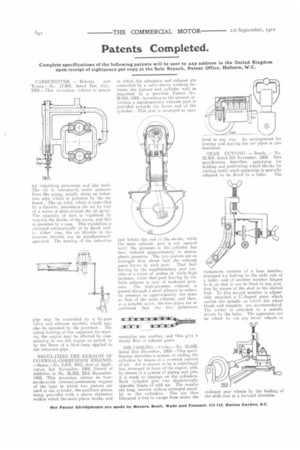Patents Completed.
Page 22

If you've noticed an error in this article please click here to report it so we can fix it.
Complete specifications of the following patents will be sent to any address in the United Kingdom upon receipt of eightpence per copy at the Sale Branch, Patent Office, Holborn, W.C.
CARBURETTER. — Roberts and Young.—No. 17,845, dated 31st July. 1909.—This invention relates to means
for vaporizing petroleum and like fuels. The oil is introduced, under pressure from the pump, axially along an induction pipe which is jacketed by the exhaust. The air inlet, which is controlled by a throttle, introduces the air by way of a series of slots around the oil spray. The quantity of fuel is regulated by varying the stroke of the pump, and this is operated by a cam. This regulation is obtained automatically or by hand, and. io either case, the air throttle or the nil inure throttle can be simultanecusly operated. The heating of the induction
pipe may be controlled by a by-pass valve and exhaust throttle, which may alao be operated by the governor. The initial heating of the vaporizer for starting the engine may be effected by commencing to run the engine on petrol, or by the flame of a blow-lamp applied to the induction pipe.
REGULATING THE EXHAUST OF INTERNAL-COMBUSTION ENGINES. —Sears.—No. 3,412, 19101 date of Application 3rd November, 1909, Patent of Addition to No. 28,265, 28th December, 1908. This invention relates to fourstroke-cycle internal-combustion engines of the type in which two pistons are used in one cylinder, the auxiliary piston being provided with a sleeve extension within which the main piston works, and
in which the admission and exhaust. are controlled by a valve sleeve working between the pistons and cylinder wall as described in a previous Patent No. 28.265, 1908. According to the present invention a supplementary exhaust port is provided towards the lower end of the cylinder. This port is arranged to open just before the cud of the stroke, while the main exhaust port is not opened until the pressure in the cylinder has been reduced approximately to atmospheric pressure. The two pistons are so arranged that about half the exhaust
ga■ECS leaves by each port. That half leaving by the supplementary port consists of a series of pulses of fairly-high pressure, while that part leaving by the main exhaust is only of moderate pressure. The high-pressure exhaust is passed through a small silencer to reduce its pressure to approximately the same as that of the main exhaust, and then, at a suitable point, the two pipes are so combined that the two pulsations
neutralize one another, and thus give a steady flow of exhaust gases.
AIR COOLING.--Cooke.—No. 29,858, dated 21st December, 1909.—This specification describes a system of cooling the cylinders by means of a constant current of air. Air is drawn in by a centrifugal fan, arranged in front. of the engine, and, by means of a system of piping and jets, it is made to impinge on the cylinders. Each cylinder gets two diametrically opposite blasts of cold air. The nozzles are long, narrow orifices arranged parallel to the cylinders. The air thus liberated is free to escape from under the hood in any way. An arrangement for bracing and staying the air pipes is also described.
GEAR CUTTING. — Beech. — No. 25,564, dated 5th November, 1909. This specification describes apparatus fur holding and positioning wheel blanks for cutting teeth ; such apparatus is specially adapted to be fitted to a lathe. The equipment consists of a base member arranged fur bolting to the slide rest of a lathe, and of another member hinged to it, so that it can be fixed in any position by means of the stud in the slotted link. To this second member is adjustably attached a U-shaped piece which carries the spindle on which the wheel blank and template are accommodated. The cutter is attached to a spindle driven by the lathe. The apparatus can be tilted to cut any bevel wheels or ordinary gear wheels by the feeding of the slide rest in a forward direction.






















